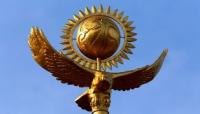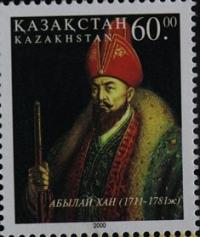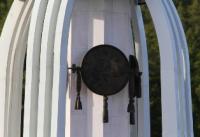Вы здесь
Stele of Abylai khan.



Monuments Akmola of province.
“I've known rivers:
I've known rivers ancient as the world and older than the flow of human blood in human veins. My soul has grown deep like the rivers”
Langston Hughes.
Coach Trips in Astana.
The stele of Abylai Khan is located in the center of Polyana Abylai Khan, in the northeastern part of the Kokshetau mountains, 756 meters from the western shore of Lake Borovoe, 4.8 kilometers to the west from the village of Burabay, in the National Natural Park Borovoe in the Burabay district of Akmola region
The stele of Abylai Khan was installed in 1991 in honor of the 280th anniversary of Abylai Khan. The concept of the work id based on the preservation and development of the traditional national culture, which is the basis for the consolidation of the society.
The place for the establishment of the stele is the historical meadow of Abylai Khan surrounded by trees near the grandiose rocks. The meadow, its round shape (circle is a symbol of eternity, infinity, space order) is the basis for the composition and idea of this artwork.
The authors maximally keep the configuration of this place sacred for the whole country putting the dominant element of the monument onto the central axis of the space where the essence of its sacral power is concentrated.
The authors use the symbols quite widely used on the territory of the Eurasian Continent, which come from the depth of the centuries and which were developed by Scythians and Saks, which were the same roots for Turk and Slavic nations who had lived in the Great Steppe.
In the plan, the monument is an octagon within the circle. In the culture of the nations in Kazakhstan an octagon symbolizes not just the parts of the world but also the prosperity spreading in all directions. In combination with the circle it establishes this prosperity forever.
When you think about the idea, you will also find another globally famous plot, which speaks about the necessity to unite: sons can easily break one arrow but can not break the bunch of arrows. The idea of the bunch of arrows is in the basis of the composition of the monument.
Its eight facets mean the unity, and the “shanyrak” connecting them (the plastic accent of the monument) is the unity in the native land. Generally the monument is made of the white metal (height is 35 meters). Its facets are decorated with golden ornament in the form of formalized arrow heads.
Proportions of the monument emphasize the direction into the future. The monument is established on the round stereobate with four steps – the sign of four ends of the world. At the one fourth if the height, some structures are adjacent to the monument.
The shape of these structures remind of “uyk”, in combination reproducing the yurta, which in its turn symbolizes the sky, i.e. the protection of gods and spirits of the ancestors (“aruakh”). “Uyk” support “shanyrak”, the poly-semantic symbol related not only to the idea about the native home, motherland but also symbolizing the sun, which brings the joy of life, which protects from hostility, and which shed bright light on the creative way of a man and the nation.
Under blessed “shanyrak” on the fore facet there is the standard of the President of the Republic of Kazakhstan who guarantees the constitutional rights of the citizens and who is the symbol for the unity of nations. On other facets there are shields decorated with the national ornament “koshkar muiz”, which symbolizes wealth, peace and welfare.
“Shashak Bau” are attached to the standard and the shields. “Shashak Bau” is the formalized picture of the Global Tree, which gives prosperity and establishes and supports life on Earth. The obelisk is completed with the spire, which has the composition of three circles (symbol of the unity of the nation) and modern emblem of Kazakhstan’s sovereignty – golden eagle (symbol of power and courage), which brings on its wings the shining sun (symbol of light, sense, spiritual morals bringing the welfare to the earth).
At the foot of the monument on the small three-step pedestal (total height of the sphere together with the stereobate is seven steps - divine number, which provides link of the earth and the heaven and the protection of God) there is a sphere, symbol of the Universe, on the surface of which there are texts addressed to the people by two creators of the independent state – Abylai Khan and N. Nazarbayev.
Thus, the authors establish the historical heritage of the modern democratic state with the democracy of the Eurasian steppe area. In front of the monument, also on round four-step stereobates, there are two altars in the form of the bowl blessed by the winged snow leopard.
Winged snow leopard (one of the totems of Kazakhs) is a symbol, which came from the Sak culture related to Turk culture. It unites two elements (water and air – spiritual and physical purity and plasticity, intellect) meaning the purity of thoughts and reasonable solution of the occurring problems, showing the unbreakable connection of the people with the native land.
According to the idea of the authors, the altars are necessary for the rituals, which promote spiritual and physical purification before seeing the sacred place. The monument is surrounded by six benches shown in the form of “besik” (cradle), which remind us of six tribes (“Alty Alash”), from which Kazakh nation started (at the same time, number “six” in the traditional culture is the number denoting the development process).
Side backs of the benches are decorated with zoomorphous ornament with the benevolent sense. The benches are flanked with the lamps, the composition of which repeats the motifs of the monument, and their completion is “tamga” (sign) of Abylai Khan.
Eight lamps distribute their light to all parts of the world. “Abylai Khan’s High Road” leads to the monument. The high road is paved with red and light tiles with the ornament depicting the formalized “tamga” of Abylai Khan.
Architectural composition along the axis is put inside of the meadow so that the view opens to the historical stone – Abylai Khan’s throne. On the opposite side from the monument on the green parterre there are two “balbala”, which depict a man and a woman.
The man is a warrior with his hawk and sword protecting his people; and the woman with the bowl symbolizes hospitality of Kazakhs. The colours used in the monuments built on the combination of red, white and gold-yellow colours create the atmosphere of joy and at the same time set the victory of life, wisdom and spiritual purity.
Thus, the monument shows the historical heritage of state establishments, and Abylai Khan is praised as one of those who have united the nations of Kazakhstan. The monument in general is understood as the symbol of Motherland, which united many people and nations, protecting people and providing wealth and prosperity, as well as spiritually praising people and leading to new successes.
The location of the monument on the central axis of the sacred area distributes its influence on Kazakh land, on all the nations of Kazakhstan. Stylistically the monument uses traditional and modern architectural and spatial shapes.
It shows the desire of the author to actualize the traditional culture, to reveal and to apply the essence basis, which comes from the living powers of the folk culture. The meadow is supplemented with the facilities of social and domestic purposes.
They are located on the other side of the road. These are three rotundas, their shapes look like the lower part of the monument, where souvenir shops can be located. Here is also a parking lot.
Geographic coordinates of the stele of Ablai Khan: N53 ° 05'01.38 "E70 ° 14'05.46"
Authority:
http://www.kazakhstan-tourist.isd.kz
Photos by
Alexander Petrov.







